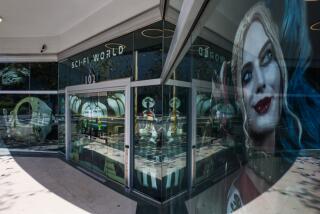Forrest J Ackerman, writer-editor who coined ‘sci-fi,’ dies at 92
- Share via
Forrest J Ackerman, who influenced a generation of young horror-movie fans with Famous Monsters of Filmland magazine and spent a lifetime amassing what has been called the world’s largest personal collection of science-fiction and fantasy memorabilia, has died. He was 92.
Ackerman, a writer, editor and literary agent who has been credited with coining the term “sci-fi” in the 1950s, died Thursday of heart failure at his home in Los Angeles, said John Sasser, a friend who is making a documentary on Ackerman.
As editor of Famous Monsters of Filmland, Ackerman wrote most of the articles in the photo-laden magazine launched in 1958 as a forum for past and present horror films.
“It was the first movie-monster magazine,” Tony Timpone, editor of horror-movie magazine Fangoria, told The Times in 2002.
Timpone, who began reading Famous Monsters as a young boy in the early ‘70s, remembered it as “a black-and-white magazine with cheap paper but great painted [color] covers. It really turned people on to the magic of horror movies.”
Primarily targeted to late pre-adolescents and young teenagers, Famous Monsters of Filmland featured synopses of horror films; interviews with actors such as Boris Karloff, Bela Lugosi and Vincent Price; and articles about makeup and special effects.
The magazine reflected Ackerman’s penchant for puns, with features such as “The Printed Weird” and “Fang Mail.” Ackerman referred to himself as Dr. Acula.
“He put a lot of his personality into the magazine,” said Timpone, who became friends with Ackerman. “It was a pretty juvenile approach to genre journalism, but as kids that’s all we had.”
Among those who grew up reading Famous Monsters of Filmland was author Stephen King. Other childhood readers included movie directors Joe Dante, John Landis and Steven Spielberg, who once autographed a poster of “Close Encounters of the Third Kind” for Ackerman, saying, “A generation of fantasy lovers thank you for raising us so well.”
Ackerman was a celebrity in his own right, once signing 10,000 autographs during a three-day monster-movie convention in New York City.
This, after all, was the man who created and wrote the comic book characters Vampirella and Jeanie of Questar and was the ultimate fan’s fan: a man who actually had known Lugosi and Karloff and whose priceless collection of science-fiction, horror and fantasy artifacts ran to some 300,000 items.
For years, Ackerman housed his enormous cache of books, movie stills, posters, paintings, movie props, masks and assorted memorabilia in his 18-room home in Los Feliz.
He dubbed the house the Ackermansion. The jam-packed repository included everything from a Dracula cape worn by Lugosi to Mr. Spock’s pointy ears and from Lon Chaney Sr.’s makeup kit to the paper-plate flying saucer used by director Ed Wood in “Plan 9 From Outer Space.”
For Ackerman, a native Angeleno born Nov. 24, 1916, it all began at age 9.
That’s when he stopped at a drugstore on the corner of Santa Monica Boulevard and Western Avenue in Hollywood and bought his first copy of the science-fiction magazine Amazing Stories.
Ackerman was helplessly hooked.
By his late teens, he had mastered Esperanto, the invented international language. In 1929, he founded the Boys Scientifiction Club. In 1932, he joined a group of other young fans in launching the Time Traveler, which is considered the first fan magazine devoted exclusively to science fiction and for which Ackerman was “contributing editor.”
Ackerman also joined with other local fans in starting a chapter of the Science Fiction Society -- meetings were held in Clifton’s Cafeteria in downtown L.A. -- and as editor of the group’s fan publication Imagination!, he published in 1938 a young Ray Bradbury’s first short story.
During World War II, Ackerman edited a military newspaper published at Ft. MacArthur in San Pedro. After the war, he worked as a literary agent. His agency represented scores of science-fiction writers, including L. Ron Hubbard, Isaac Asimov, A.E. van Vogt, H.L. Gold, Ray Cummings and Hugo Gernsback.
In 1954, Ackerman coined the term that would become part of the popular lexicon -- a term said to make some fans cringe.
“My wife and I were listening to the radio, and when someone said ‘hi-fi’ the word ‘sci-fi’ suddenly hit me,” Ackerman explained to The Times in 1982. “If my interest had been soap operas, I guess it would have been ‘cry-fi,’ or James Bond, ‘spy-fi.’ ”
At the time, Ackerman already was well-known among science-fiction and horror aficionados for his massive collection. After a couple from Texas showed up on his doorstep in 1951 asking to view the collection, Ackerman began opening up his home for regular, informal tours on Saturdays. Over the years, thousands of people made the pilgrimage to the Ackermansion.
The Dracula/Frankenstein room featured a casket as a “coffin table” and the cape Lugosi wore in the stage version of “Dracula.” A case displayed one of the horror film legend’s bow ties, which, Ackerman would gleefully note, contained a drop of blood.
Among the collection’s other highlights: the ring worn by Lugosi in “Dracula,” the giant-winged pterodactyl that swooped down for Fay Wray in “King Kong,” Lon Chaney’s cape from “The Phantom of the Opera” and “Metropolis” director Fritz Lang’s monocle.
The affable Ackerman would escort his visitors through the priceless warren of books, posters and memorabilia, settling into a chair in each room and answering questions.
“He was always just a big kid,” said Fangoria’s Timpone. “I really cherished all the times I’ve been with him.”
Ackerman wrote more than 2,000 articles and short stories for magazines and anthologies, sometimes under the pseudonyms Dr. Acula, Weaver Wright and Claire Voyant.
He also wrote what has been reported to be the first lesbian science-fiction story ever published, “World of Loneliness.” And under the pen name Laurajean Ermayne, he wrote lesbian romances in the late 1940s for the lesbian magazine Vice Versa.
Ackerman edited or co-edited numerous books, including “A Book of Weird Tales” and “365 Science Fiction Short Stories.”
Over the years, he made numerous cameo appearances in films, including Dante’s “The Howling” and Landis’ “Innocent Blood.” Landis also had Ackerman eating popcorn behind Michael Jackson in the movie theater scene in his “Thriller” video.
Famous Monsters of Filmland ceased publication in 1983, but returned a decade later with Ray Ferry as publisher and Ackerman as editor. Ackerman, however, reportedly had a falling out with Ferry and left the magazine. Years of litigation followed. In 2000, after a civil trial, Ackerman won a trademark infringement and breach-of-contract lawsuit against Ferry, though he said a year later that he had not yet collected a penny of the judgment.
In recent decades, according to a 2003 Times story, Ackerman slowly sold pieces of his massive collection in order to survive. Because of health problems and his still-unresolved legal battle, he put up all but about 100 of his favorite objects for sale in 2002.
The same year, he moved out of the Ackermansion and into a bungalow in the flats of Los Feliz. But he continued to make what was left of his collection available for fans to view on Saturday mornings.
“I call it the Acker Mini-Mansion,” he said.
Ackerman’s wife, Wendayne, died in 1990; he has no surviving family members.
McLellan is a Times staff writer.
More to Read
Start your day right
Sign up for Essential California for the L.A. Times biggest news, features and recommendations in your inbox six days a week.
You may occasionally receive promotional content from the Los Angeles Times.






